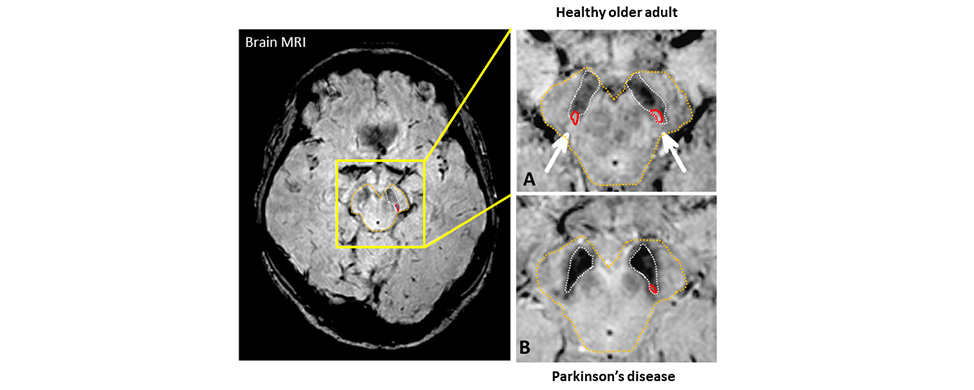
Andrew Rowlands, Assoc Prof Gabrielle Todd and Glen Rowlands discuss the most recent research at the University of South Australia
Researchers at UniSA are looking at a specific area of the brain for a means of earlier and more accurate diagnosis for Parkinson’s disease. This research is made possible thanks to people such as the Rowlands family who have donated funds in memory of their wife and mother, Joy.
Joy Rowlands was a hard-working woman, devoted to her family and community. Retiring at the age of 60, she spent the next few years enjoying time with her grandchildren and travelling widely with her husband Glen. When Joy became concerned by her deteriorating handwriting and increasing anxiety, she sought medical advice and doctors eventually diagnosed Parkinson’s disease. Glen Rowlands has been kind enough to share their story.
Current research at the University of South Australia is focusing on the Magnetic Resonance Imaging (MRI) appearance of a brain structure called the substantia nigra, a movement-related brain region that is most impacted by Parkinson’s disease.
“In 94 per cent of patients with Parkinson’s disease, the appearance of a part of the substantia nigra, called nigrosome-1, is abnormal on an MRI image of the brain,” says Assoc Prof Todd. “The abnormality is a proposed biomarker for Parkinson’s disease and can aid diagnosis.”

At present assessment of nigrosome-1 typically involves a radiologist assessing whether the appearance of nigrosome-1 is normal or abnormal. This method is challenging due to differences in the visual appearance of nigrosome-1 between scanners and a reliance on subjectivity. These challenges are a barrier to routine use of this imaging biomarker in the diagnosis of Parkinson’s disease. Assoc Prof Gabrielle Todd and her team have been working on a solution to this problem by developing a quick and simple method for measuring the characteristics of nigrosome-1 that is suitable for use in clinical settings.
A lack of understanding about what this brain region should look like normally and whether the appearance differs between males and females, or if it changes with age, is another barrier to the use of MRI of nigrosome-1 in the diagnosis of Parkinson’s disease. “To address this problem, we measured the appearance of nigrosome-1 in more than 100 healthy adults aged 18 to 80 to gather values to compare patients,” says Assoc Prof Todd. They also studied a group of patients with Parkinson’s disease, and how the nervous system was functioning in both groups of participants. “The latter offered an opportunity to explore the relationship between the appearance of nigrosome-1 and movement and cognitive performance.” The work recently concluded and is being prepared for publication in medical journals.
Parkinson’s disease is a type of neurological disorder that affects one to three per cent of adults aged over 60 . The disease has a significant effect on parts of the brain involved in the control of movement. It’s this damage that leads to a set of characteristic movement problems, including tremor. The disease also affects other parts of the nervous system, and this can result in a range of other symptoms, which may be evident before the onset of any movement issues. Examples of other symptoms include constipation, reduced sense of smell, altered function of the cardiovascular system, and problems with memory, cognition, and mood (depression and anxiety).
The cause of Parkinson’s disease is not yet known but is thought to involve an interaction between environmental factors and genetic susceptibility. Some of the known environmental risk factors include exposure to certain pesticides and herbicides and living in a rural community. People aged over 60 are more at risk of Parkinson’s disease.
There is no cure for Parkinson’s disease and current treatments seek to reduce the severity of symptoms. The most common type of treatment involves medication, which is associated with frequent and severe side effects, including additional movement problems. Some people living with Parkinson’s disease may also be eligible for deep brain stimulation which involves inserting a device deep in the brain to change the activity in neural circuits that are involved in movement.
If you would like to make a tax deductible donation to support this research, please contact the lead researcher Associate Professor Gabrielle Todd.

100% of your gift will go directly to support Parkinson's disease research at UniSA - there are no administration fees, no overheads and no hidden costs.
Support our researchers continue their work in preventing illness, improving health systems and services, creating more effective therapies, and advancing health equality.
